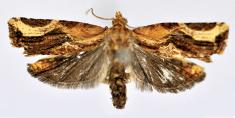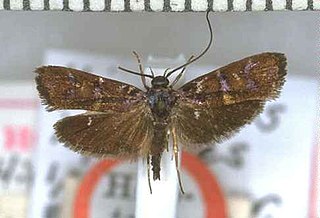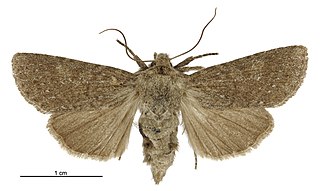
Chilades lajus, the lime blue, is a small butterfly found in India, Sri Lanka, Myanmar, Taiwan, Hong Kong, Hainan, Mangulam Island, Sulawesi and the Philippines that belongs to the lycaenids or blues family.

Prosotas noreia, the white-tipped lineblue, is a species of lycaenid butterfly found in South Asia and Java.

Catochrysops strabo, the forget-me-not, is a small butterfly found in Asia that belongs to the lycaenids or blues family. The species was first described by Johan Christian Fabricius in 1793. It is found in Sri Lanka, India, from Sikkim to Indochina and in Sundaland, Sulawesi and the Philippines.
Licigena is a monotypic genus of moths belonging to the subfamily Olethreutinae of the family Tortricidae. Its sole species is Licigena sertula, which has been found in Sri Lanka. Both the genus and species were first described by Alexey Diakonoff in 1982.
Sychnochlaena is a monotypic moth genus belonging to the family Tortricidae first described by Alexey Diakonoff in 1982. Its only species, Sychnochlaena megalorhis, described by the same author in the same year, is found in Sri Lanka.

Zealandopterix zonodoxa is a moth of the family Micropterigidae. It is endemic to New Zealand and is located from Hawkes Bay north as well as on Poor Knights, Little Barrier and the Great Barrier Islands. It is the smallest micropterigid in New Zealand and the shiny white markings on the forewing of this species display variation. It is a moth that is active during the day, but has been collected using UV light. Adults are on the wing from September to March and the species has been witnessed visiting the flowers of Nīkau and Cordyline pumilio in large numbers. It inhabits a wide variety of moist indigenous forest but is associated with forests in which podocarps are common. Larvae have been sieved from rotten wood on the floor of a mixed podocarp/broadleaf forest or extracted from moss or from bryophytes.

Isodemis stenotera is a moth of the family Tortricidae. It is known from China and Indonesia (Sumatra).

Cryptaspasma querula is a moth of the family Tortricidae. It is endemic to New Zealand and can be found throughout the country. This species inhabits podocarp and broadleaf forest. The larvae consume parts of the seeds and fruits of tawa, tarairi and miro trees and are predated upon by the invasive to New Zealand house mouse. Adults are variable in appearance and also in size. They are on the wing throughout the year and are nocturnal but are attracted to light. They can be found having flown inside houses and have also been observed resting on fences or other human made structures during the day.
Brenthia leptocosma is a species of moth of the family Choreutidae. It is found on Mauritius and Réunion in the Indian Ocean.
Rhynchoferella syncentra is a moth of the Copromorphidae family. It is found in Madagascar and South Africa, where it is known from Kwazulu-Natal, Mpumalanga and Gauteng.
Eupoecilia anisoneura is a species of moth of the family Tortricidae first described by Alexey Diakonoff in 1982. It is found in Sri Lanka.
Metacosmesis aelinopa is a moth in the family Carposinidae first described by Alexey Diakonoff in 1982. It is found in Sri Lanka.

Pyrgotis eudorana is a species of moth of the family Tortricidae. It is endemic in New Zealand and has been observed in both the North and South Islands. However it is regarded as a rare insect. This species inhabits native forest. Larvae exclusively feed on Muehlenbeckia australis and adults are on the wing from November to April. Adults are attracted to light.

Eudonia alopecias is a moth in the family Crambidae. It was described by Edward Meyrick in 1901. It is endemic to New Zealand and has been found at Aoraki / Mount Cook in February.

Hierodoris iophanes is a moth of the family Oecophoridae. It was described by Edward Meyrick in 1912. This species can be distinguished from others in its genus by the purple metallic colouration as well as the blue-white mark on its forewings. It is endemic to New Zealand, where it has been recorded from Auckland to Southland. This species inhabits native forest or scrub, with the adults preferring open glades. They are known to be on the wing from November until February and fly during daylight hours, being active on hot sunny days. Larvae feed on the interior of twigs of Prumnopitys ferruginea. The twigs had evidence of oviposition scars of cicadas and the larvae were collected in October after reddish-brown frass indicated their location within the twigs.
Spanistoneura acrospodia is a moth of the family Tortricidae first described by Alexey Diakonoff in 1982. It is found in Sri Lanka.
Pammenemima ochropa is a moth of the family Tortricidae first described by Edward Meyrick in 1905. It is found in Sri Lanka and its Barberyn Island.
Dasodis microphthora is a moth of the family Tortricidae first described by Edward Meyrick in 1936. It is found in Sri Lanka, Java and the western Caroline Islands.
Age onychistica is a moth of the family Tortricidae first described by Alexey Diakonoff in 1982. It is found in Sri Lanka, It is also found in Africa and Indonesia.

Ichneutica sollennis is a moth of the family Noctuidae. This species is endemic to New Zealand. This species is known from the eastern and central areas of the southern South Island. It inhabits alpine zones and has been collected in tussock grasslands. The life history of this species is unknown. Although the host species is currently unknown it has been hypothesised that this species have grass or grass like plants as host plants. Adults are on the wing from November to February and are attracted to light.








